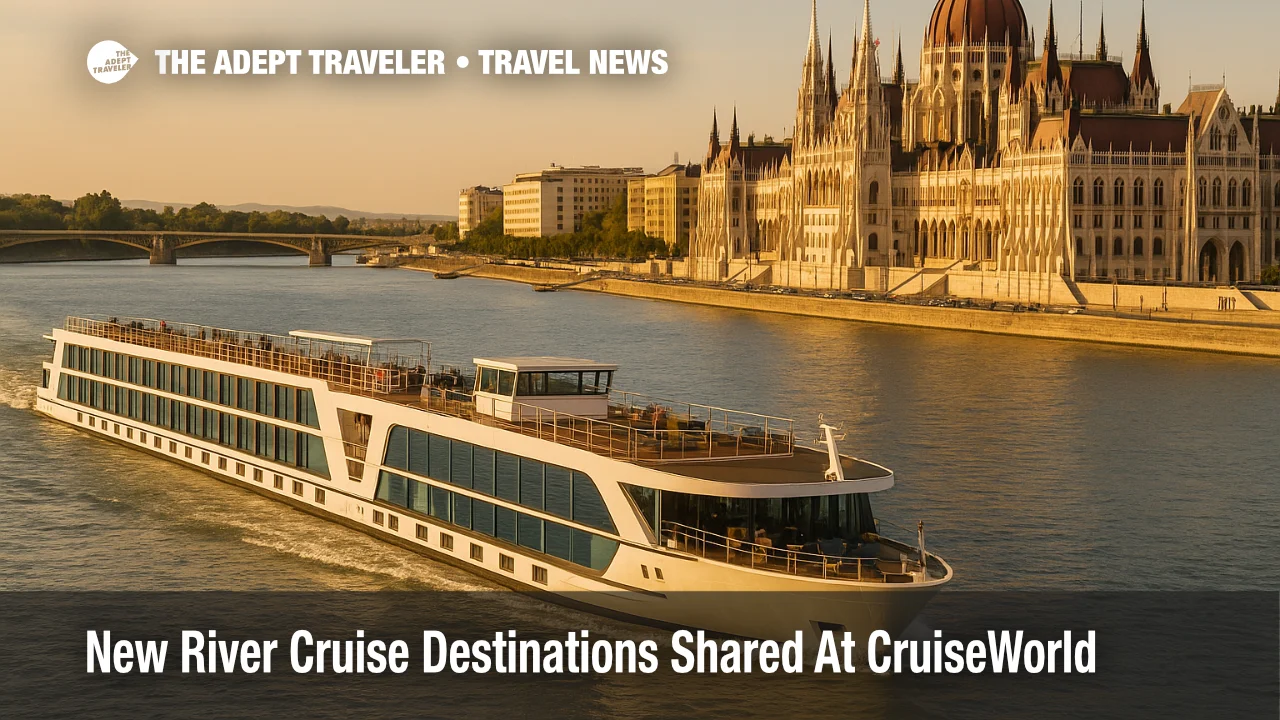New River Cruise Destinations Take Center Stage At CruiseWorld

Key points
- CruiseWorld's river and small ship panel highlighted expansion beyond Europe to India, China, and Colombia
- Brands on stage included AmaWaterways, Antara, Avalon, Century, Riviera, and VIVA, with varied deployment timelines
- Celebrity's new river program adds competitive pressure and fresh demand, especially for 2027 and beyond
- Advisors were urged to focus on visas, insurance, and seasonal water-level variability for emerging routes
Impact
- Destinations To Watch
- Ganges and Brahmaputra in India, Yangtze in China, Magdalena in Colombia, plus secondary European rivers
- Booking Windows
- Open 9 to 15 months ahead for peak seasons, longer for inaugural or limited-capacity sailings
- Operational Variables
- Expect seasonal water-level constraints, occasional coach swaps, and port clearance nuances on developing routes
- Advisor Actions
- Pre-qualify clients on comfort with long-haul air, vaccines or visas, and ship size differences versus Europe
- Who Is Affected
- River-curious ocean cruisers, culture-focused travelers, and guests seeking smaller ships or new geography
River cruising stepped out of Europe's shadow at CruiseWorld in Fort Lauderdale on November 6, as a main-stage panel framed the next growth wave around India, China, and Colombia. Executives from AmaWaterways, Antara, Avalon Waterways, Century Cruises, Riviera River Cruises, and VIVA Cruises sketched where inventory is coming, how operations will adapt outside the Rhine-Danube playbook, and what travelers should expect on first-wave seasons. For advisors, the headline is simple, new geography is moving from "future curiosity" to "bookable reality," with lead-time, documentation, and risk planning now central to the sale.
The nut of the shift is supply and intent. Several panelists described concrete or near-term capacity on non-European rivers, including Antara's India portfolio, Century's China operations, and emerging Latin America options that put Colombia's Magdalena back on radar. While exact deployment dates vary by brand, the message to sellers was to prepare clients for different operating rhythms, more involved pre-trip checklists, and, at times, higher complexity than a standard Budapest-to-Vilshofen Danube run.
A parallel storyline is competitive gravity. Ocean players are leaning inland, which widens the funnel of first-time river prospects. Celebrity's move into river cruising changes the conversation for loyalty-led households and multigenerational groups who know the brand, but have not tried river. That could pull demand forward for classic Europe seasons even as Asia and Latin America build mindshare, a dynamic advisors can use to lock inventory before shoulder and holiday peaks price up.
Latest developments
Travel Weekly's on-site coverage of the "Beyond the Ocean" session captured the panel's through-line: sailings beyond Europe are shifting from side-notes to center stage, with India, China, and Colombia repeatedly cited. The agenda confirms the participating brands and moderators, anchoring who said what and why it matters for 2026 through 2028 planning cycles. If your clients equate river cruising with only the Rhine and Danube, this is the cycle to re-educate them.
Analysis
For travelers, the upside is access to cultures, wildlife corridors, and cityscapes that ocean ships cannot reach. For operations, the constraints are real, river pilots, seasonal water levels, dredging schedules, and port formalities vary widely outside Europe. Expect more itinerary caveats, such as partial sailing with coached segments, different tendering practices, and local security protocols that can feel more like expedition travel than a floating city. Advisors should price in flexibility and make documentation, visas, vaccinations, and comprehensive travel insurance non-negotiable line items. Air planning adds another layer, long-haul gateways with fewer daily frequencies make misconnect buffers, premium-cabin buy-ups, and overnight staging far more valuable than on a Paris or Munich feed.
Background
Modern river cruising scaled up on Europe's arterial rivers because infrastructure is mature, locks and water management are predictable, and airport feeds are dense. Outside Europe, ships often face monsoon cycles, sediment shifts, and port agencies that are still tuning cruise workflows. None of that is a deal-breaker, it is the operating context. Brands with deep destination partnerships, such as Indian-flag Antara on the Ganges or legacy Chinese operators like Century on the Yangtze, can mitigate surprises through local crews, shore-side spares, and flexible routing. Where a line is new, advisors should probe for contingency playbooks before collecting final payment.
Another watch item is capacity signaling versus concrete berths. Press and panels often precede final port and clearance guarantees, so it pays to map cancellation and change clauses and to favor sailings that already appear in reservation systems with bonded payment rails. This is particularly true for inaugural seasons that may slip a quarter to catch dredging windows or new-build handovers. The reward for early movers is outsized client satisfaction, smaller ships, higher guide ratios, and shore programs that feel closer to land tours than group tourism. The trade-off is accepting a bit more operational variability than Europe's fixed-itinerary comfort.
Final thoughts
River cruising's center of gravity is widening. Europe remains the anchor, but advisors who master India, China, and Colombia now will control the most interesting inventory of 2026 to 2028, with differentiated experiences that convert ocean loyalists and culture seekers alike. Start with candid expectation-setting, then layer in smarter air, insurance, and documentation. That is how these "new geography" river cruise destinations move from panel hype to smooth, satisfied travel.
